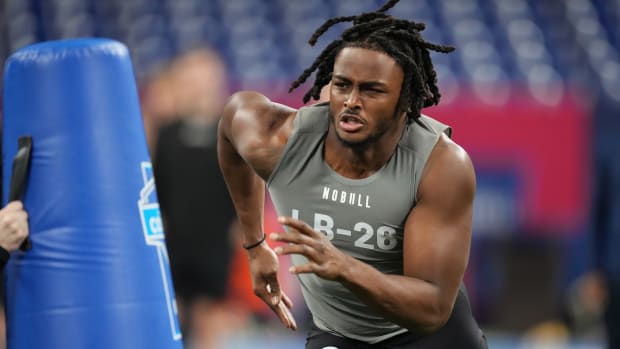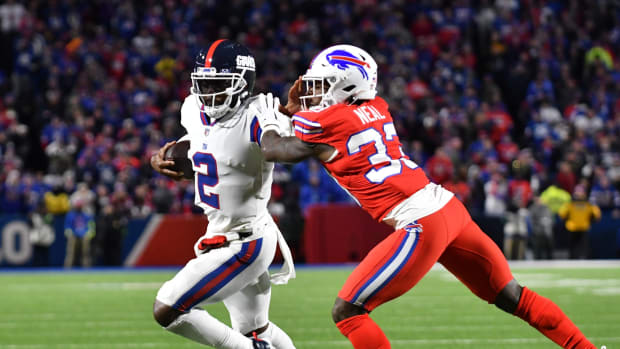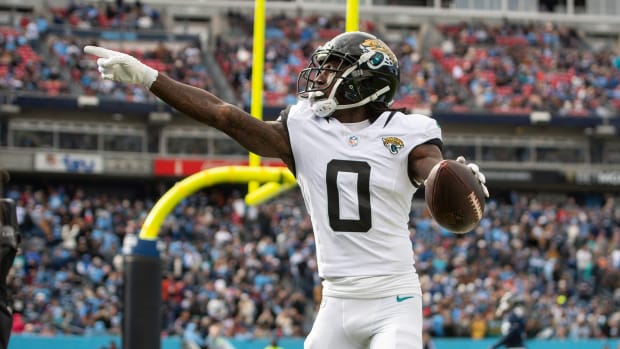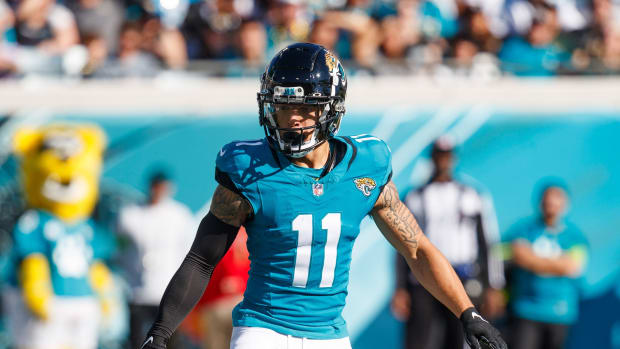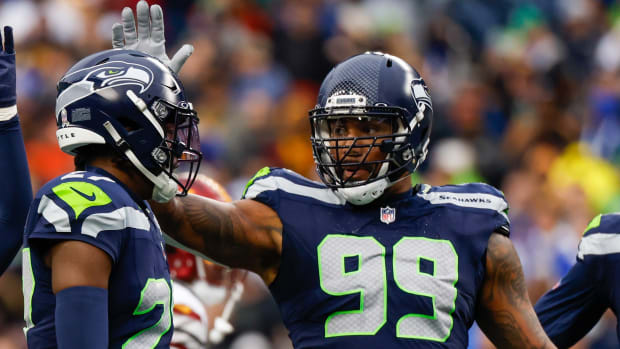Dwayne Haskins Has an NFL Decision to Make
Dwayne Haskins shuffles into Ohio State’s media room wearing a pair of shearling moccasin slippers. He sighs and places his hands flat on the podium, his face expressionless. His nonchalant body language and straightforward answers give no hint of what he’s just done on the field. Forty-five minutes earlier, he had thrown his sixth touchdown of the day against Indiana, tying an Ohio State record. His 455 passing yards were three short of the school record. He shrugs it off, probably because performances like this have become Haskins’s standard.
The redshirt sophomore quarterback waited his turn behind J.T. Barrett for two seasons, and his studying as a backup has clearly paid off. In six games this season, he leads all Division I quarterbacks with 25 touchdown passes. He’s thrown for 1,919 yards, completed 71.7% of his passes and led Ohio State to a 6-0 start, staking out his spot in the Heisman conversation.
Haskins is on track to complete his degree early, a clue of what might come. And the buzz in scouting circles has been that, if he has a Heisman-type season, Haskins will strongly consider foregoing his remaining two years of eligibility and entering the 2019 draft. That’s why scouts have been flocking to Columbus to evaluate him as a potential first-round pick.
They’ve seen a quarterback with size (6' 3", 220), arm strength and accuracy. He has a quick release, he can throw it from different platforms and he can get the ball out while taking a hit. He isn’t much of a threat in the run game—not the way Barrett was for the Buckeyes—but Haskins is mobile.
His first touchdown pass against the Hoosiers on Saturday was an example of the NFL-type plays he can make. Haskins and the Buckeyes carried out a play-action fake, but the left guard pulling to the right side was tripped up and fell, giving a blitzing linebacker a clear path to the quarterback, who had begun to roll to that side. Haskins saw the guard go down, knew the pressure was coming and backed up, giving himself enough room to reset and target receiver Johnnie Dixon, running a post route from the right slot. The throw connected with Dixon five yards deep in the left side of the end zone, a 39-yard score. The arm strength and accuracy when his protection broke down is what evaluators want to see more of.
There are also evaluators who think Haskins would benefit greatly from another year in school. When defenses pressure Haskins he can get rattled and rush a throw, though it’s a habit that should improve with experience. Like many young quarterbacks, his footwork and accuracy slide when he faces significant pressure—and so far this season, Haskins hasn’t had to face a lot of it. Penn State in Week 5 was the most challenging game he’s had at Ohio State, with the Nittany Lions consistently sending extra defenders at him. Haskins was noticeably out of rhythm in the first half, affected by the rush. In the second half, Ohio State switched to a quicker-pace tempo offense to beat the blitz and get Haskins back into his rhythm. It worked, and the Buckeyes came away with a win, but it was the kind of performance that has some NFL evaluators hoping he’ll stay in Columbus for one more year.
The majority of draft prospects have more than one season as a starter on their résumé. There’s no foolproof predictor for success, but more experience is an undeniable benefit, for the player and for evaluators. There are not only more plays on tape, but with opposing defenses able to better customize game plans in the second or third season, the quarterback is forced to adjust like he’ll have to at the NFL level.
When Mark Sanchez left USC after his first year as a starter to enter the 2009 draft, Pete Carroll, the Trojans’ head coach at the time, voiced his disagreement with his choice. “After analyzing all the information, the truth is there—he should’ve stayed for another year,” Carroll said at the time. “One more year of running a team is almost priceless, so he lost the chance to fully prepare himself and become the very best he could be before going to the NFL.”
If Haskins leaves for the draft after this season, his limited body of work will present a challenge to evaluate. Recent examples of one-year starters who entered the draft are an eclectic bunch: Mitchell Trubisky, Cardale Jones, Brock Osweiler, Cam Newton and Sanchez. Their careers run the gamut.
Trubisky’s college career is probably the most similar to Haskins’s. Along with being Haskins’s contemporary, Trubisky was a more talented passer and better suited to the NFL game than predecessor Marquise Williams, but had to wait his turn because Williams was established as a team leader and successful at the college level. When he got his shot as a junior, Trubisky had an impressive year and made the leap to the draft. Chicago traded up to take him with the second overall pick of the 2017 NFL draft, so that part of the decision worked out well for Trubisky. But he sat the first four games of his rookie season then struggled in a rebuilding offense. His breakout performance came just two Sundays ago, passing for six touchdowns against Tampa Bay.
However, Haskins has a benefit that most one-year starters do not: He’s been mentored by several former and current NFL players, from ex-Pro Bowl cornerback Shawn Springs to former offensive lineman George Hegamin to current Falcons receiver Mohamed Sanu, who coached Haskins in Pop Warner football in his home state of New Jersey.
Springs first discovered Haskins when the quarterback was a seventh grader at a passing camp for middle school football players in Hillsborough, N.J. Springs was sitting in the stands watching his son Skyler, a sixth grader at the time, when he noticed a chubby kid with a killer arm. “I see this little kid out there throwing the ball,” he says. “My son is in the same line and I'm like geez, my son is throwing it like 20 yards and Dwayne is throwing it like 50 yards.”
After the practice ended, Springs followed the kid with the big arm and introduced himself to his dad, Dwayne Haskins Sr. The two dads hit it off, and Springs became a close family friend and mentor to Dwayne Jr., so close that Haskins Sr. turned down an interview request for this story but passed along Springs’s contact info to speak on his behalf. After that passing camp, whenever Springs went to New Jersey for his own football camps or other business he’d stop by the Haskins family home in Highland Park to watch film with Dwayne Jr., who he says had an advanced football IQ for his age. “He’s in eighth grade and on tape, he is already like a senior in high school,” Springs says. “I would escalate the conversation a little more, like, He,y when it's Cover 3, Cover 4... I’m talking to him like he is a high school or college kid, and he is only 14 at the time and he got it.”
Haskins played freshman football at St. Anthony’s in Jersey City, a school known for its basketball program. Springs felt the young QB wouldn’t reach his potential there. He suggested to Dwayne Sr. and wife Tamara that the family relocate to the Montgomery County, Md., area where Spring lives, and where he knew there was great football competition as well as high-level academics. “I said, Dwayne, man to man, and Miss Tammy, we’ve got to move Dwayne,” Springs says. “We’ve got to get him in a better area for football.”
So the Haskins family visited Montgomery County for a weekend that fall. Springs hosted and took them to a Good Counsel game, which featured a receiver named Stefon Diggs and a cornerback named Kendall Fuller. The Haskins were sold, and Springs worked a connection to get Dwayne Jr. and his younger sister into Bullis, a private school with a strong academic reputation and football program. Both parents found new jobs in Maryland, and Haskins became Bullis’s starting quarterback the following season, his sophomore year.
Springs still talks ball with Haskins, and gives him feedback every Monday after his games. After the one-point comeback win on the road at Penn State, Springs told Haskins: “You've got to respect the game. Every game is not going to be four or five touchdowns in a half. Some games you gotta earn it. People forget that was only your fifth start, going into Penn State on the road, they are blitzing you and you saw a whiteout. That is extremely hard to overcome.”
The Next Wentz? Justin Herbert Is Turning Heads
On Saturday morning, like most mornings, Haskins woke up to a text from his dad.
Saturday scripture
1 Samuel 16:7
But the Lord said unto Samuel, Look not on his countenance or on the height of his stature; because I have refused him: for the Lord seeth not as a man seeth; for man looketh on the outward appearance but the Lord looketh on the heart.
IT’S ALL ABOUT YOUR HEART.
Haskins does have the stature of an NFL quarterback but Hegamin, another ex-NFL mentor, says it’s his mental makeup that matters most. “His poise is something that I have only seen in one quarterback I played for: Troy Aikman,” Hegamin says. “Extremely consistent. Most of our conversations were about, How do I handle being the leader of this Bullis team right now, and then, When I go to college what should I expect? And how should I go about maintaining that leadership at the college level, specifically knowing that he was going to Ohio State and going to play behind one of Ohio State’s beloved sons, J.T. Barrett.”
Hegamin first met Haskins at an Under Armour camp when Haskins was a sophomore in high school. A little while later, Hegamin moved his family from Texas to Montgomery Country, for the same reasons the Haskins family did, and his son became football teammates with Haskins at Bullis. “I don’t believe if they stay in New Jersey, that he sees that same level of success,” he says.
Hegamin played with Troy Aikman in Dallas for four years, and sees the same consistency in Haskins that Aikman was known for. “There was never a time that I saw Troy make a significant mistake and not be able to come back from it,” he says. “For me, being a young player, coming into the Cowboys, I saw his consistency as one of his best attributes. When I look at someone like Dwayne and I see him maintain his high level of consistency regardless of the situation, it is really hard not to compare the two.”
Springs sees another quarterback in Haskins, one he played with at the end of his 13-year NFL career. “Tom Brady. Dwayne would ask me questions like, what was Tom like?” Springs says. “And I’m like, Man, he was a hard worker. Dwayne is the same mode, he works on his craft.”
In Hegamin’s role as a global ambassador for Under Armour and the director of scholastic outreach for the NFLPA, he has mentored and worked with around 900 college football players, around 300 of whom have gone on to the NFL. “Out of all of the kids that I have been involved with transitioning from high school to college, that have the potential to go the next level, he has an excellent chance of transitioning into one of the best pros, because of his mental side and what he can do on the field,” he says.
After his junior year at Ohio State, Springs was faced with the same kind of tough decision Haskins will have to make this offseason. Springs was named All-America and Big Ten defensive player of the year in the 1996, and he felt like he’d accomplished everything he could on the field except that he hadn’t yet won a national championship and hadn’t been voted a team captain.
The main advice he’ll give to Haskins is the same thing he asked himself after the 1996 season. “What makes you happy?” he says. “Will you be excited to go back to college another year and win another award? One of the things we talk about is your obligation as a student-athlete is to the Ohio State University. You want to leave your legacy there. What is that going to mean 20 years from now, when you bring your kids back to the university? What is your legacy?”
Springs answered that question for himself and chose to leave Ohio State with a year of eligibility remaining. He was the No. 3 pick in the 1997 draft, still the highest cornerback ever drafted. Haskins’s choice will depend on how he plays the rest of this season, and what becomes of the Buckeyes’ shot at a national title. All the while, NFL scouts will be watching closely.
Drew Lock Is Poised to Rise Up NFL Draft Boards
A SCOUT’S NOTES
NFL evaluators introduce you to the players they’re keeping an eye on this season…
David Montgomery, RB, Iowa State
A lot of guys are talking about him. He’s really good. Probably a third-round, maybe second-round guy. He’s very productive. Physically, he’s not the biggest guy in the world, but he is very instinctive as a runner. He sees the hole really quickly, he has really good feet. The first guy does not usually get him down. His yards after contact is really good. Everybody talks about 40-yard dash, and that’s fun to talk about but with RBs, but the 40 is just extra. What matters is, does he see the hole? Is he strong and tough? Does he stay off the ground after first contact and does he have enough acceleration to clear a hole when he’s there?
Jonathan Crawford, S, Indiana
He’s probably a late-round guy, but he’s the best player on Indiana’s defense and he’s got something interesting there. He looks the part, he’s really athletic.
Devin Bush, LB, Michigan
He’s from Florida but none of the Florida schools recruited him. He was an under-recruited guy because of his size. He plays like he still cares about that and is trying to prove those guys wrong. He’s really good, a fast and aggressive linebacker.
SENIOR BOWL SCOUTING NOTEBOOK
Former longtime NFL scout and current Reese’s Senior Bowl Executive Director Jim Nagy shares the matchups he’s monitoring this week…
Oregon DE/OLB Jalen Jelks vs. Washington RT Kaleb McGary
Quickness versus power. Bend against bulk. Call it whatever you want, but this will be a matchup of contrasting tools and skill-sets in the Pacific Northwest on Saturday when Washington travels to Eugene to take on Oregon.
The Huskies feature some bigger names, such as underrated QB Jake Browning and record-setting RB Myles Gaskin, but in all likelihood RT Kaleb McGary will be the first UW player taken in the NFL draft. Going into the season, there was some debate among scouts as to whether it would be McGary or left tackle Trey Adams who would hear their name called first but a back injury ended Adams’s season before it started. We have stated it before in this column and it is worth repeating that NFL teams covet experienced major program offensive linemen and Saturday will be McGary’s 40th career start.
With only five senior starters, the Ducks are an extremely young team and Jelks is widely regarded by NFL scouts as their top draftable player. There is talk that ultra-talented junior QB Justin Herbert could leave early but if he decides to stay in school then Jelks is the Ducks’ best chance of having a player drafted in the first three rounds.
In this week’s matchup, let’s start with the size factor. Our first live exposure to McGary was in the season-opener against Auburn and he is a big man. Evaluations are, to a degree, incomplete without seeing a player up-close because a player’s body type is a critical part of projection to the next level, and McGary has the frame that NFL teams are looking for on the edge. Conversely, Jelks is sleek, thinner-hipped, and very lean. Scouts are going to love Jelks’s length, however, his lack of lower bulk will put him at a disadvantage against McGary if he is asked to hold the point-of-attack on a consistent basis.
On run-downs, Jelks does a good job setting the edge when he plays over tight ends because he has the shock in his hands to stun people. But engaging and holding his ground against a bigger bodied guy like McGary in the run game could be a challenge. One of the things that stood out when we saw McGary play live against Auburn’s big, physical defensive front was how initially quick and mobile he was. We came into that game thinking McGary might possess some prototypical right tackle athletic limitations but that’s hardly the case. Most right tackles prospects are shorter-area plodders but McGary does some good things pulling, cutting off the backside, and working up to the second-level. His athleticism will be put to the test this week against Jelks, who makes the majority of his plays working edges and chasing plays down from behind.
In passing situations, this will not be an all-day type of matchup because Oregon likes to move Jelks around on sub-downs. Most of the time, Jelks will standup and rush off the edge from a two-point stance, however, he will reduce inside, sometimes to nose tackle, where he can use his good get-off quickness against interior offensive lineman and his range to loop outside. When they do square-off, McGary will have to stay patient in his pass sets against Jelks. Scouts we have spoken with are intrigued by Jelks’s combination of twitch and length and he has the cross-face quickness to get McGary off-balance if McGary is not disciplined in his technique. The one area that might prevent McGary from being a swing tackle at the next level would be his ability to handle wide speed rushers, so this will be a game that NFL scouts focus on when trying to determine how much position flexibility McGary will have as a pro.
Another long-bodied senior defender to keep an eye on in this game is three-year starting OLB Justin Hollins, who had sacks in each of Oregon’s first four games. When we saw Oregon play at Cal earlier this year, Hollins looked like a HWS (height/weight/speed) player that could ascend thru the process, especially for 3-4 teams.
The Senior Bowl has already seen each of these teams play live once and we are scheduled to see Washington play again when they travel to Cal on October 27.
The ‘Other’ Josh Allen Makes a Name for Himself in NFL Draft Circles
OTHER MATCHUPS TO WATCH
Michigan State WR Felton Davis vs. Penn State CB Amani Oruwariye
In last year’s matchup, Davis had 12 receptions for 181 yards and one TD while Oruwariye made one of the most impressive interceptions of the season. Both are taller, above-the-rim players who should have some jump-ball opportunities on Saturday.
Michigan TE Zach Gentry vs. Wisconsin LBs Ryan Connelly, T.J. Edwards, and Andrew Van Ginkel
Gentry is an ascending prospect and he is coming off his best receiving game of the season (7 receptions, 112 yards) but will have his work cut out for him both blocking and receiving against the trio of Connelly, Edwards, and Van Ginkel, which might be the best senior group in the nation.
Nebraska WR Stanley Morgan vs. Northwestern CB Montre Hartage
Morgan and Hartage are both tough, productive Big Ten players that still need to showcase one defining trait that will translate to NFL success. They have a good opportunity to do so in this intriguing outside matchup.
Baylor WR Jalen Hurd vs. Texas CB Kris Boyd
Hurd bet on himself with his position change from RB to WR and he will be challenged by the physicality and aggressiveness of Boyd, who is putting together a very solid senior season.
Georgia DE Jonathan Ledbetter, LBs D’Andre Walker and Natrez Patrick vs. LSU RB Nick Brossette
Brossette waited his turn at LSU and he is taking advantage of the opportunity this season. NFL scouts will want to see what he does against Georgia’s front-seven, including senior prospects like Ledbetter, Walker, and Patrick.
• Question or comment? Email us at talkback@themmqb.com.



































